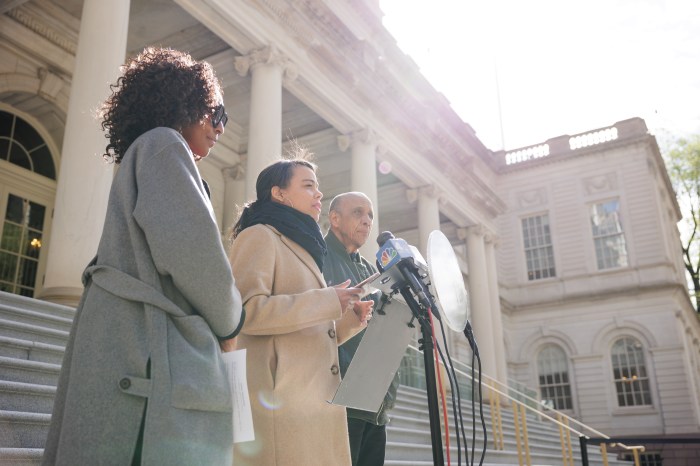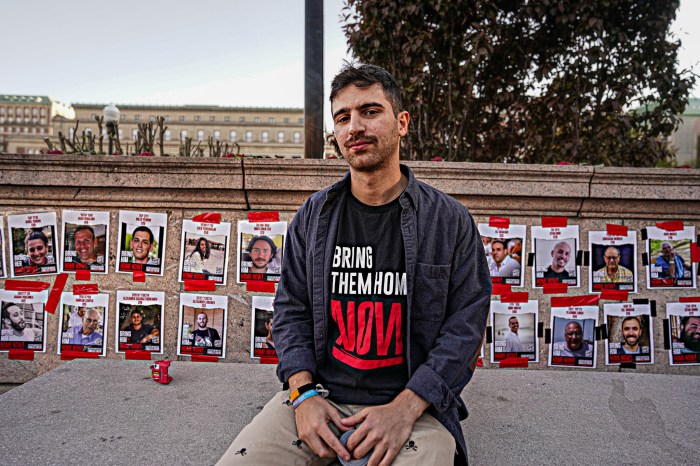Manhattan State Supreme Court Justice Frank P. Nervo ruled on April 11 that the former same-sex partner of a woman who adopted a child from Africa after the women’s relationship ended could not maintain a lawsuit seeking custody and visitation with the child based on the relationship she developed with the child after the adoption took place.
In one of the first applications of last August’s historic New York Court of Appeals co-parent ruling in Brooke S.B. v. Elizabeth A.C.C., Nervo found that plaintiff Kelly Gunn failed to show by “clear and convincing evidence” that she and her former partner, Circe Hamilton, had agreed to adopt and raise the child together. Such evidence would have brought the case within the conceptual sphere — if not the precise holding — of the Brooke S.B. precedent.
Gunn announced she will appeal the ruling to the Appellate Division’s First Department in Manhattan, and seek an extension of the 20-day stay Nervo put on his ruling.
Trial judge won’t apply, extend scope of NY high court’s 2016 co-parenting precedent
Nervo’s consideration of the 2016 precedent from the state’s highest bench was complicated by its limitations. Brooke S.B. was a consolidation of two separate cases, both involving donor insemination where former partners planned for and carried out their child’s birth as part of their relationship, with an explicit mutual agreement they would both be parents. In both cases, the couples lived together with the child before separating.
Gunn’s case posed different facts.
In its Brooke S.B. ruling, written by the late Judge Sheila Abdus-Salaam, the Court of Appeals cautiously abandoned its prior bright line test, under which a biologically-unrelated same-sex co-parent was treated as a legal stranger without standing to seek custody or visitation. The 2016 ruling made a specific exception for situations where a parental relationship was created by mutual consent within the context of donor insemination.
“Because we necessarily decide these cases based on the facts presented to us,” Abdus-Salaam wrote in that case, “it would be premature for us to consider adopting a test for situations in which a couple did not enter into a pre-conception agreement. Accordingly, we do not now decide whether, in a case where a biological or adoptive parent consented to the creation of a parent-like relationship between his or her partner and child after conception, the partner can establish standing to seek visitation and custody.”
Gunn and Hamilton, who entered into a cohabitation agreement” in 2007, were together until 2009. “It is undisputed that during their relationship, they entered into a plan to adopt and raise a child together,” Nervo wrote. “It is also undisputed that the parties’ relationship deteriorated over time and they entered into a separation agreement on May 28, 2010.”
About 10 months later, Hamilton learned that a child was available for adoption in Ethiopia and took steps to complete the adoption. Gunn claims that despite their separation, she facilitated the adoption through a substantial monetary payment as part of their separation agreement, which made it possible for Hamilton to “establish a home sufficient to pass inspection by the adoption agency.”
Gunn also arranged a business trip so she could travel with Hamilton and the child, Abush, on the London-to-New York part of Hamilton’s trip home after getting custody of the boy in Ethiopia. Gunn presented evidence of her continuing relationship with Abush, though she conceded “her involvement with the child was limited because [Hamilton] would disapprove.”
Hamilton argued that the couple’s plan to adopt and raise a child together “dissolved contemporaneously with the dissolution of the parties’ relationship.” Gunn’s involvement after she adopted the child, Hamilton asserted, was “only a supportive role as a close friend.” Gunn was “merely a godmother,” not a parent, said Hamilton, who argued she did not “encourage, facilitate, or condone a parental relationship” between Gunn and the boy, who is now seven years old.
In attempting to adapt the Brooke S.B. ruling to the facts in this case, Nervo interpreted the earlier case to extend to an adoption situation — but only if the plaintiff could show, by clear and convincing evidence, that the parties planned to adopt the child and raise it together and carried out their plan within the context of their continuing relationship. He found that the two women had such a plan prior to their separation, but it did not continue through the adoption process and the raising of the child.
The timing of Gunn’s lawsuit is interesting. Hamilton adopted Abush in 2011, but Gunn did not file her lawsuit until September 1, 2016, two days after the Court of Appeals decided Brooke S.B. Prior to then, her suit would have been blocked by the earlier precedent the Court of Appeals overruled, Alison D. v. Virginia M. from 1991. In an April 20 article, the New York Times reported that Gunn went to court “to prevent her former partner… from moving to her native London” with the child. Her complaint first went before Justice Matthew F. Cooper, who issued an interim order restraining Hamilton from relocating Abush to London while the case was pending. The case was then assigned to Nervo, who held hearings sporadically from last September 8 until February 16 of this year.
Nervo’s ruling this month granted Hamilton’s motion to dismiss the case, denied Gunn’s motion, and vacated Justice Cooper’s order restraining Hamilton’s travel to London with Abush. However, recognizing that Gunn would likely appeal and could have grounds to argue that last year’s Court of Appeals’ precedent should be given a broader reading, Nervo stayed his order for 20 days. A prompt appeal could extend that stay while the case gets appellate review.
In a lengthy summary of testimony from both women, Nervo wrote, “Upon the presentation of the evidence of both parties over 36 days of testimony, constituting a hearing transcript of 4,738 pages, 215 exhibits on behalf of petitioner, and 126 exhibits on behalf of respondent, the court finds the petitioner has on numerous occasions stated that she did not want to be a parent and gave no indication to either respondent or third parties that she either wanted this role or acted as a parent. Therefore, she has failed to establish by clear and convincing evidence that she has standing as a parent” in line with the Brooke S.B. precedent.
The court never addressed the best interest of the child, usually a key finding in a custody dispute, because a plaintiff must first establish their status as a parent or otherwise show some extraordinary circumstances. Part of Gunn’s argument on appeal will likely be that Brooke S.B. implicitly overruled the extraordinary circumstances requirement in cases involving same-sex partners who had jointly planned to raise a child together — even in cases not involving donor insemination or a continuous relationship.
Reading through Nervo’s summary of the evidence — which is unlikely to be upset on appeal, as appellate courts generally refrain from second-guessing trial judges’ findings of facts in custody and visitation cases — it seems he concluded that while Gunn has formed a relationship with Abush perhaps deeper than a mere acquaintanceship or what a babysitter might forge, there was significant evidence she had expressed reservations during her relationship with Hamilton about the adoption plans and had never directly communicated to her ex-partner after the adoption that she desired to take on co-parenting responsibilities.
Given the Court of Appeals’ emphasis last year that standing would arise from a mutual agreement between the child’s biological or adoptive parent and her same-sex partner, the lack of evidence of such an agreement at or after the time of this adoption meant this case could not be made to fit precisely into the Brooke S.B. precedent.
At the same time, since the Court of Appeals specifically stated last year it was not ruling on factual situations different from those in Brooke S.B., the Appellate Division could take a different view.
The Court of Appeals clearly rejected the bright line test of the old Alison D. v. Virginia M. case, but whether it will countenance a broader exception to the standing rules it carved out last year is uncertain.
Gunn’s attorney, Nancy Chemtob, told the New York Times, “I believe that this decision doesn’t follow Brooke.”
The Times reported that “Bonnie Rabin, one of Ms. Hamilton’s lawyers, said the ruling should allay concerns that a trusted caretaker could suddenly claim parental rights under the state’s expanded definition of parentage. ‘That would be scary to parents,’ she said.”

































